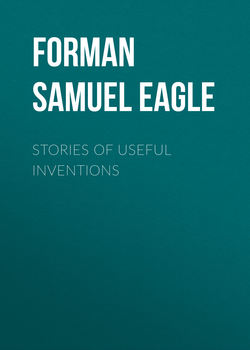Stories of Useful Inventions

Реклама. ООО «ЛитРес», ИНН: 7719571260.
Оглавление
Forman Samuel Eagle. Stories of Useful Inventions
PREFACE
A FOREWORD1
THE MATCH
THE STOVE
THE LAMP
THE FORGE
THE STEAM-ENGINE
THE PLOW
THE REAPER
THE MILL
THE LOOM
THE HOUSE
THE CARRIAGE
THE CARRIAGE. Continued
THE BOAT
THE CLOCK
THE BOOK
THE MESSAGE
Отрывок из книги
These stories of useful inventions are chapters in the history of civilization and this little book is a book of history. Now we are told by Herodotus, one of the oldest and greatest of historians, that when the writer of history records an event he should state the time and the place of its happening. In some kinds of history – in the history of the world's wars, for example, or in the history of its politics – this is strictly true. When we are reading of the battle of Bunker Hill we should be told precisely when and where the battle was fought, and in an account of the Declaration of Independence the time and place of the declaration should be given. But in the history of inventions we cannot always be precise as to dates and places. Of course it cannot be told when the first plow or the first loom or the first clock was made. Inventions like these had their origin far back in the earliest ages when there was no such person as a historian. And when we come to the history of inventions in more recent times the historian is still sometimes unable to discover the precise time and place of an invention.
It is in the nature of things that the origin of an invention should be surrounded by uncertainty and doubt. An invention, as we shall see presently, is nearly always a response to a certain want. The world wants something and it promises a rich reward to one who will furnish the desired thing. The inventor, recognizing the want, sets to work to make the thing, but he conducts his experiments in secret, for the reason that he does not want another to steal his ideas and get ahead of him. We can see that this is true in respect to the flying machine. The first experiments with the flying machine were conducted in secret in out of the way places and pains were taken that the public should know as little as possible about the new machine and about the results of the experiments. The history of the flying machine will of course have to be written, but because of the secrecy and mystery which surrounded the beginnings of the invention it will be extremely difficult for the future historian to tell precisely when the first flying machine was invented or to name the inventor. If it is so difficult to get the facts as to the origin of an invention in our own time, how much more difficult it is to clear away the mystery and doubt which surround the beginnings of an invention in an age long past!
.....
The second step in fire-making was taken when it was discovered that a spark can be made by striking together a stone and a piece of iron ore. Strike a piece of flint against a piece of iron ore known as pyrites, or fire-stone, and you will make sparks fly. (Fig. 5.) Let these sparks fall into small pieces of dried moss or powdered charcoal, and the tinder, as the moss or the charcoal is called, will catch fire. It will glow, but it will not blaze. Now hold a dry splinter in the glowing tinder, and fan or blow with the breath and the splinter will burst into a flame. If you will tip your splinter with sulphur before you place it in the burning tinder, you will get a flame at once. This was the strike-a-light, or percussion, method of making a fire. It followed the friction method, and was a great improvement upon it because it took less work and a shorter time to get a blaze. The regular outfit for fire-making with the strike-a-light consisted of a tinder-box, a piece of steel, a piece of flint, and some splinters tipped with sulphur (Fig. 6). The flint and steel were struck together, and the sparks thus made fell into the tinder and made it glow. A splinter was applied as quickly as possible to the tinder, and when a flame was produced the candle which rested in the socket on the tinder-box was lighted. As soon as the splinter was lighted the cover was replaced on the tinder-box, so as to smother the glowing tinder and save it for another time.
FIG. 6. – TINDER BOX, FLINT, STEEL, AND SULPHUR-TIPPED SPLINTERS.
.....